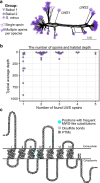The diversity of opsins in Lake Baikal amphipods (Amphipoda: Gammaridae)
- PMID: 33971810
- PMCID: PMC8108468
- DOI: 10.1186/s12862-021-01806-9
The diversity of opsins in Lake Baikal amphipods (Amphipoda: Gammaridae)
Abstract
Background: Vision is a crucial sense for the evolutionary success of many animal groups. Here we explore the diversity of visual pigments (opsins) in the transcriptomes of amphipods (Crustacea: Amphipoda) and conclude that it is restricted to middle (MWS) and long wavelength-sensitive (LWS) opsins in the overwhelming majority of examined species.
Results: We evidenced (i) parallel loss of MWS opsin expression in multiple species (including two independently evolved lineages from the deep and ancient Lake Baikal) and (ii) LWS opsin amplification (up to five transcripts) in both Baikal lineages. The number of LWS opsins negatively correlated with habitat depth in Baikal amphipods. Some LWS opsins in Baikal amphipods contained MWS-like substitutions, suggesting that they might have undergone spectral tuning.
Conclusions: This repeating two-step evolutionary scenario suggests common triggers, possibly the lack of light during the periods when Baikal was permanently covered with thick ice and its subsequent melting. Overall, this observation demonstrates the possibility of revealing climate history by following the evolutionary changes in protein families.
Keywords: Ancient ecosystems; Crustacea: Malacostraca: Amphipoda; Lake Baikal; Parallel evolution; Vision.
Conflict of interest statement
The authors declare that they have no competing interests.
Figures





References
-
- Cronin TW, Johnsen S, Marshall NJ, Warrant EJ. Visual ecology. Princeton: Princeton University Press; 2014.
-
- Land MF, Nilsson D-E. Animal eyes. Oxford: Oxford University Press; 2012.
Publication types
MeSH terms
Substances
Associated data
LinkOut - more resources
Full Text Sources
Other Literature Sources
